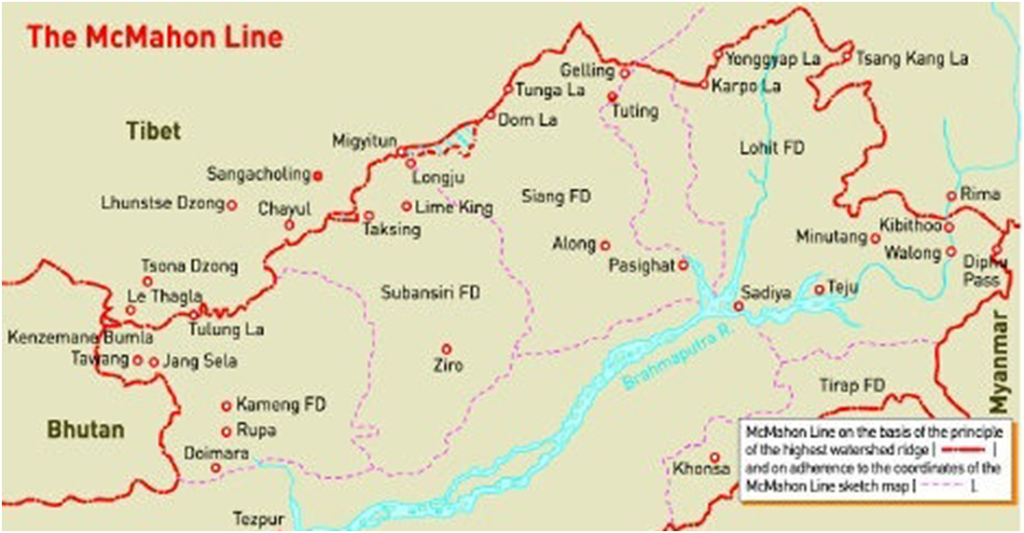
What is the origin of the border dispute between India and China?
After the British left, membership of all international organizations and treaties signed by British India devolved to India.
After the communists took power, China pulled out of all international agreements and “unequal treaties” imposed on it during its “century of humiliation”, and demanded re-negotiation of all borders.
The border between China and India has never been delimited.
Must read: Rise of the People’s Republic of China (PRC) as a great power and its implications
What is the McMahon Line?
At the 1914 China-Tibet-Britain Simla Convention, Sir Henry McMahon, foreign secretary of British India, drew up the 890-km McMahon Line as the border between British India and Tibet.
The line, drawn primarily on the highest watershed principle, marked out previously unclaimed/undefined borders between Britain and Tibet.
The line put Tawang and other Tibetan areas in the British empire.

The line was forgotten until the British government published the documents in the 1937 edition of Aitchison’s Collection of Treaties.
Subsequently, China refused to accept the line.
Must read: Belt and Road Initiative – One Belt One Road
Was there an effort to resolve the boundary dispute before the 1962 war?
In January 1960, the Chinese politburo decided to open negotiations with India, and reach an understanding through “mutual understanding and mutual concessions”.
In an assessment for the politburo, Premier Zhou Enlai envisioned a limited agreement, and suggested China should be ready for a delay in resolving the dispute.
Nehru and Zhou met in April 1960, and agreed on only a detailed examination of the claims by their officials.
Over the next two years, both sides sought to preserve their claims by posting troops along the border.
In the 1962 war, the PLA quickly overpowered the Indian troops.
Must read: String of pearl theory
What is the Line of Actual Control (LAC)?
It is supposed to divide areas under Indian and Chinese control since the end of the 1962 war. Unlike the LoC, the LAC was not mutually agreed upon. This was because the war ended with a unilateral ceasefire by China.
In the Ladakh sector, the question of where exactly Chinese forces stood after the war remains contested.
In the Arunachal sector, China treats the McMahon Line as the LAC. But it challenges India’s claim that it should follow the watershed, i.e., the highest line of the mountains, because the coordinates of the McMahon Line in the 1914 agreement depart at places from the watershed.
There is hardly any dispute about the LAC in the Central Sector, which is in Uttarakhand and Himachal Pradesh.
Where do the Chinese incursions occur?

In areas which both sides claim lie on their side of the LAC. The LAC is contested heavily in the Ladakh sector.

In the Eastern sector, contested areas are south of the watershed. There are many more reported cases of incursions in Ladakh than in the Eastern Sector.
When did border negotiations resume?
Ambassadors were exchanged in 1976, foreign minister Atal Bihari Vajpayee visited Beijing in 1979, and eight rounds of official talks took place between 1981 and 1987.
Prime Minister Vajpayee’s visit to China in 2003 led to the agreement on appointing special representatives (SRs) and, in April 2005, there was agreement on the political parameters and principles that would underpin negotiations. The aim was a comprehensive solution encompassing all three sectors.
The agreed boundary would follow well-defined geographical features and respect the interests of the settled populations. It tacitly acknowledged India’s concerns over places like Tawang by agreeing that settled areas were not up for bargaining, and took China’s demands into account by suggesting that the watershed principle may not be ironclad.
Many round of talks have been held since 2003.
What has been the progress of talks?
Not as much as expected. The two sides have not been able to exchange maps giving their versions of the LAC, except in the Central Sector.
Given the differing notions of the LAC, and the hard position taken by China, no exercise in clarification is likely to succeed easily.
The countries have been wary of showing their hand; there is not much clarity on what compromises they could sell to domestic constituencies.
With the difficulty in delineating the LAC, what is the way forward?
Under Vajpayee, India initially insisted on talks to clarify the LAC, but by 2003, came round to the view that pending progress on the LAC, it was essential to begin negotiations on the international boundary.
The 2005 agreement provides an ideal basis for settlement by mutual concessions. But settlement of the international border has proved elusive due to political concerns.
